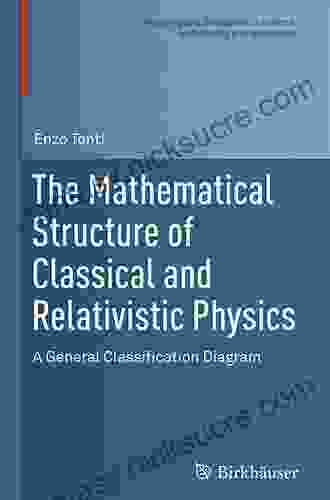General Classification Diagram Modeling and Simulation in Science and Engineering

A general classification diagram (GCD) is a graphical representation of a system's components and their relationships. GCDs are used in a variety of fields, including science, engineering, and business. In science, GCDs can be used to represent the relationships between different elements of a system, such as the components of a cell or the parts of an ecosystem. In engineering, GCDs can be used to represent the relationships between different components of a system, such as the components of a machine or the parts of a building. In business, GCDs can be used to represent the relationships between different parts of a company, such as the different departments or the different levels of management.
5 out of 5
| Language | : | English |
| File size | : | 31169 KB |
| Text-to-Speech | : | Enabled |
| Enhanced typesetting | : | Enabled |
| Word Wise | : | Enabled |
| Print length | : | 767 pages |
GCD modeling and simulation is the process of creating and using GCDs to represent and analyze systems. GCD modeling can be used to identify the components of a system and their relationships, and to understand how the system works. GCD simulation can be used to predict the behavior of a system under different conditions, and to identify potential problems.
GCD Modeling
The first step in GCD modeling is to identify the components of the system and their relationships. This can be done by observing the system, by reading about the system, or by talking to experts about the system. Once the components and relationships have been identified, they can be represented in a GCD.
There are a variety of different ways to represent GCDs. One common way is to use a hierarchical diagram. In a hierarchical diagram, the components of the system are arranged in a tree structure, with the most general components at the top of the tree and the most specific components at the bottom of the tree.
Another common way to represent GCDs is to use a network diagram. In a network diagram, the components of the system are represented by nodes, and the relationships between the components are represented by edges.
The choice of which type of diagram to use depends on the nature of the system being represented. Hierarchical diagrams are well-suited for representing systems that have a clear hierarchical structure. Network diagrams are well-suited for representing systems that have a complex network of relationships.
GCD Simulation
Once a GCD has been created, it can be used for simulation. Simulation is the process of using a computer to model the behavior of a system. GCD simulation can be used to predict the behavior of a system under different conditions, and to identify potential problems.
There are a variety of different ways to simulate GCDs. One common way is to use a discrete-event simulation. In a discrete-event simulation, the behavior of the system is modeled as a series of discrete events. Each event occurs at a specific time, and the state of the system changes as a result of the event.
Another common way to simulate GCDs is to use a continuous-time simulation. In a continuous-time simulation, the behavior of the system is modeled as a continuous function of time. This type of simulation is often used to model systems that change continuously over time, such as the flow of water in a pipe or the growth of a population.
The choice of which type of simulation to use depends on the nature of the system being simulated. Discrete-event simulations are well-suited for modeling systems that change in discrete steps. Continuous-time simulations are well-suited for modeling systems that change continuously over time.
Applications of GCD Modeling and Simulation
GCD modeling and simulation has a wide variety of applications in science, engineering, and business. Some of the most common applications include:
- System design: GCD modeling and simulation can be used to design new systems or to improve existing systems. By simulating the behavior of a system under different conditions, engineers can identify potential problems and design solutions to avoid them.
- Process optimization: GCD modeling and simulation can be used to optimize the performance of existing processes. By simulating the behavior of a process under different conditions, engineers can identify bottlenecks and inefficiencies and design solutions to improve the process.
- Decision making: GCD modeling and simulation can be used to support decision making. By simulating the behavior of a system under different conditions, decision makers can identify the best course of action to take.
GCD modeling and simulation is a powerful tool that can be used to improve the design, operation, and performance of systems in a wide variety of fields.
GCD modeling and simulation is a valuable tool for understanding and improving systems. By representing the components of a system and their relationships in a graphical format, GCDs can help to identify potential problems and design solutions. By simulating the behavior of a system under different conditions, GCDs can help to predict the behavior of the system and identify potential problems. GCD modeling and simulation is a powerful tool that can be used to improve the design, operation, and performance of systems in a wide variety of fields.
References
- [1] Wymore, A. W. (1993). Model-based systems engineering. CRC Press.
- [2] Law, A. M., & Kelton, W. D. (2000). Simulation modeling and analysis. McGraw-Hill.
- [3] Zeigler, B. P., Praehofer, H., & Kim, T. G. (2000). Theory of modeling and simulation: Discrete event & iterative system computational foundations. Academic Press.
Image Credits
- Figure 1: [Image of a hierarchical diagram]
- Figure 2: [Image of a network diagram]
Alt Tags
- Figure 1: Hierarchical diagram of a system
- Figure 2: Network diagram of a system
5 out of 5
| Language | : | English |
| File size | : | 31169 KB |
| Text-to-Speech | : | Enabled |
| Enhanced typesetting | : | Enabled |
| Word Wise | : | Enabled |
| Print length | : | 767 pages |
Do you want to contribute by writing guest posts on this blog?
Please contact us and send us a resume of previous articles that you have written.
 Fiction
Fiction Non Fiction
Non Fiction Romance
Romance Mystery
Mystery Thriller
Thriller SciFi
SciFi Fantasy
Fantasy Horror
Horror Biography
Biography Selfhelp
Selfhelp Business
Business History
History Classics
Classics Poetry
Poetry Childrens
Childrens Young Adult
Young Adult Educational
Educational Cooking
Cooking Travel
Travel Lifestyle
Lifestyle Spirituality
Spirituality Health
Health Fitness
Fitness Technology
Technology Science
Science Arts
Arts Crafts
Crafts DIY
DIY Gardening
Gardening Petcare
Petcare Andrea Cremer
Andrea Cremer Bryan Irwin
Bryan Irwin H P Lovecraft
H P Lovecraft Kat Kruger
Kat Kruger John Muir Laws
John Muir Laws Jamie Dumas
Jamie Dumas Lee Gutkind
Lee Gutkind Dashka Slater
Dashka Slater Joshua Becker
Joshua Becker Gary Player
Gary Player Claudia Mazzucco
Claudia Mazzucco Marilee Lebon
Marilee Lebon Jeff Wheeler
Jeff Wheeler Zavonda Vinson Parrish
Zavonda Vinson Parrish Scarlett Curtis
Scarlett Curtis Simon Buxton
Simon Buxton Valeria Ray
Valeria Ray Claire Russell
Claire Russell Shelby Mahurin
Shelby Mahurin Bill Gutman
Bill Gutman Gail Fay
Gail Fay Melissa Abramovitz
Melissa Abramovitz Sang H Kim
Sang H Kim Herschel Knapp
Herschel Knapp S W Wilcox
S W Wilcox Rachna Chhachhi
Rachna Chhachhi Holger Schutkowski
Holger Schutkowski Matthew Bowling
Matthew Bowling Wanza Leftwich
Wanza Leftwich Robert Bruce Thompson
Robert Bruce Thompson Dylan Tomine
Dylan Tomine Betsy Herman
Betsy Herman Robert Greene
Robert Greene Larry Baush
Larry Baush Editors Of Sports Illustrated
Editors Of Sports Illustrated Suzannah Rowntree
Suzannah Rowntree Billy Martin
Billy Martin Sue L Hamilton
Sue L Hamilton Holly Jackson
Holly Jackson Evan Purcell
Evan Purcell Joan Roughgarden
Joan Roughgarden Leah Day
Leah Day George Mahood
George Mahood Laurie Rubin
Laurie Rubin Dr Nancy L Nolan
Dr Nancy L Nolan Peter Aitken
Peter Aitken Kenny Dill
Kenny Dill Aylette Jenness
Aylette Jenness Christopher Banecks
Christopher Banecks Editors Of Garden And Gun
Editors Of Garden And Gun Geraldine Van Bueren
Geraldine Van Bueren Deborah Blum
Deborah Blum Olivia Gordon
Olivia Gordon Edwin H Friedman
Edwin H Friedman Frank S Ring
Frank S Ring Ellen Schuthof Lesmeister
Ellen Schuthof Lesmeister Ian Tuhovsky
Ian Tuhovsky Gianna Sobol
Gianna Sobol T Edward Nickens
T Edward Nickens Doug Scott
Doug Scott Silvia Dunn
Silvia Dunn Henry M Cowles
Henry M Cowles Margo Armstrong
Margo Armstrong Elsevier
Elsevier Chris Fischer
Chris Fischer Jeffrey Lindsey
Jeffrey Lindsey David E Johnson
David E Johnson Jessica Wiebe
Jessica Wiebe Max Help Workbooks
Max Help Workbooks Shawn Levy
Shawn Levy Craig Chappelow
Craig Chappelow Helen Irlen
Helen Irlen James Dashner
James Dashner Richard W Fisher
Richard W Fisher Marie Max House
Marie Max House Martin Davies
Martin Davies Frank Giampaolo
Frank Giampaolo Greg Witt
Greg Witt Peter Julius Sloan
Peter Julius Sloan Zoe Hana Mikuta
Zoe Hana Mikuta Martyn Denscombe
Martyn Denscombe Ezekiel Eversand
Ezekiel Eversand Michael Tlanusta Garrett
Michael Tlanusta Garrett John C Norcross
John C Norcross Tony Ortega
Tony Ortega Russ Harris
Russ Harris Morgan Oostra
Morgan Oostra Diana Wynne Jones
Diana Wynne Jones Stephen Arterburn
Stephen Arterburn David Joyce
David Joyce Blaine Bartel
Blaine Bartel Elizabeth Thompson
Elizabeth Thompson Michael J Tougias
Michael J Tougias Yakima Canutt
Yakima Canutt Fred H Croom
Fred H Croom Issai Chozanshi
Issai Chozanshi Sara Dyer
Sara Dyer Terry Pratchett
Terry Pratchett Dave Pine
Dave Pine Mercedes Lackey
Mercedes Lackey Carlos Torres
Carlos Torres John Kettle
John Kettle Patrick Mcginty
Patrick Mcginty Sandra Davidson
Sandra Davidson Marisa Imon
Marisa Imon Linda Bauer
Linda Bauer Tony Guerra
Tony Guerra Daniel J Velleman
Daniel J Velleman Mary Griffith
Mary Griffith Nrup Parikh
Nrup Parikh Eric A Weiss Md
Eric A Weiss Md Jedd K Parkinson
Jedd K Parkinson Richard Post
Richard Post Manoj Sharma
Manoj Sharma Dan Yaccarino
Dan Yaccarino Sam Harris
Sam Harris Anya Kamenetz
Anya Kamenetz Blake Sebring
Blake Sebring Charles Simpson
Charles Simpson David E Stuart
David E Stuart Laurence Price
Laurence Price Frederica Relly
Frederica Relly Ross Edgley
Ross Edgley Steven M Levy
Steven M Levy Michael W Eysenck
Michael W Eysenck Thomas Bailey
Thomas Bailey Hilary Nangle
Hilary Nangle Chris Sajnog
Chris Sajnog Robert A Pelcovits
Robert A Pelcovits Charles Goodwill
Charles Goodwill Rachel Burgess
Rachel Burgess Fiona Danks
Fiona Danks Joseph Edminister
Joseph Edminister Jacqueline B Persons
Jacqueline B Persons Susan M Orsillo
Susan M Orsillo Karen Armstrong
Karen Armstrong Jeremy Paxman
Jeremy Paxman Michael Matthews
Michael Matthews Bex Gunn
Bex Gunn Isabel Fonseca
Isabel Fonseca Meagan Trayler
Meagan Trayler Mark Vanhoenacker
Mark Vanhoenacker Jojo Siwa
Jojo Siwa Luciano Floridi
Luciano Floridi Charles Duhigg
Charles Duhigg Tara Bianca
Tara Bianca Krista Tippett
Krista Tippett Beck Weathers
Beck Weathers Tom Dodd
Tom Dodd Joseph Campbell
Joseph Campbell Rocky Mcelveen
Rocky Mcelveen Henry Nicholls
Henry Nicholls Tim Weston
Tim Weston Ramona Finn
Ramona Finn Ron Elbe
Ron Elbe William F Keegan
William F Keegan Stephanie Manley
Stephanie Manley Joshua Foer
Joshua Foer Ted Kaczynski
Ted Kaczynski Rick Reilly
Rick Reilly Mark Solms
Mark Solms Genius Reads
Genius Reads Rod Powers
Rod Powers Charles A Rhodus
Charles A Rhodus G William Barnard
G William Barnard Chris Ferrie
Chris Ferrie Dan Garner
Dan Garner Gary Kamiya
Gary Kamiya Lucas Bessire
Lucas Bessire Dan Hamilton
Dan Hamilton Jared Derksen
Jared Derksen Kent Hrbek
Kent Hrbek Hugh Neill
Hugh Neill C D Holmes Miller
C D Holmes Miller Elizabeth King
Elizabeth King Karen Palacios Jansen
Karen Palacios Jansen Mike Westerfield
Mike Westerfield Michael D Alessio
Michael D Alessio Bob Glover
Bob Glover Ian Wilson
Ian Wilson Holly Donahue Singh
Holly Donahue Singh James R Payne
James R Payne Dawn Huebner
Dawn Huebner Ross Bonander
Ross Bonander Mosby
Mosby Irene Mceachen
Irene Mceachen Heather Long
Heather Long Izzy Judd
Izzy Judd Bill Patton
Bill Patton Henry Charles Lea
Henry Charles Lea Scott Wilson
Scott Wilson Erin Mckittrick
Erin Mckittrick James Alexander Currie
James Alexander Currie Bill Schneider
Bill Schneider Supersummary
Supersummary Carl B Tolman
Carl B Tolman Bryan Mann
Bryan Mann Michael Lempert
Michael Lempert Marsha Vanwynsberghe
Marsha Vanwynsberghe Paul Levy
Paul Levy Ginger Sinsabaugh
Ginger Sinsabaugh Brad States
Brad States Cheryl Marlene
Cheryl Marlene Bill Miller
Bill Miller Eric H Cline
Eric H Cline Robert P Beebe
Robert P Beebe Gary Dean Quesenberry
Gary Dean Quesenberry Styrling Strother
Styrling Strother Sue Enquist
Sue Enquist Ingrid Chalufour
Ingrid Chalufour Sheila Mackechnie Murtha
Sheila Mackechnie Murtha Stacie Mahoe
Stacie Mahoe Paula Yoo
Paula Yoo Virginia Smith Harvey
Virginia Smith Harvey Gavin Weightman
Gavin Weightman J D Gauchat
J D Gauchat Erin Mcrae
Erin Mcrae Jen Castleberry
Jen Castleberry Clifford A Pickover
Clifford A Pickover Alan Lawrence Sitomer
Alan Lawrence Sitomer Bob Duff
Bob Duff Zane Grey
Zane Grey Jonathan Crichton
Jonathan Crichton John Mccollister
John Mccollister Dan Murphy
Dan Murphy Conway X Bowman
Conway X Bowman Jitendra Chouksey
Jitendra Chouksey Bill Moeller
Bill Moeller Sharon Bergen
Sharon Bergen Al Walsh
Al Walsh Kevin C Kelleher Md Md
Kevin C Kelleher Md Md Shannon Sovndal
Shannon Sovndal Yau Ming Ng Thompson
Yau Ming Ng Thompson David Benjamin
David Benjamin Rabbi Jason Sobel
Rabbi Jason Sobel Rebekah Nathan
Rebekah Nathan Pedro Urvi
Pedro Urvi J Douglas Faires
J Douglas Faires Jim Greenwood
Jim Greenwood Bharath Ramsundar
Bharath Ramsundar Ken Venturi
Ken Venturi Michael Volkmar
Michael Volkmar Mark Booth
Mark Booth The Uk Mathematics Trust
The Uk Mathematics Trust Thomas Cleary
Thomas Cleary Steven Hassan
Steven Hassan Harlan Coben
Harlan Coben General
General Megan Mcgrory Massaro
Megan Mcgrory Massaro Vanessa Lapointe
Vanessa Lapointe Douglas W Ota
Douglas W Ota Steve Schwartz
Steve Schwartz R E Skibiski
R E Skibiski Kristopher Martel
Kristopher Martel Jamie Aten
Jamie Aten Bill Gladstone
Bill Gladstone Sharmila Desai
Sharmila Desai Jessica Denay
Jessica Denay Bjorn Kiggen
Bjorn Kiggen Jamie Foxx
Jamie Foxx Vukota Boljanovic
Vukota Boljanovic Donncha Hanna
Donncha Hanna Erin Beaty
Erin Beaty Davi Kopenawa
Davi Kopenawa Bev Pettersen
Bev Pettersen Bill Streever
Bill Streever Robert Byron
Robert Byron Kindle Edition
Kindle Edition Tiffany Bergin
Tiffany Bergin Tom Humphrey
Tom Humphrey Jennifer Shannon
Jennifer Shannon P J E Peebles
P J E Peebles Victoria Johnson
Victoria Johnson Lisa Dorfman
Lisa Dorfman Marc Bona
Marc Bona Louis Sachar
Louis Sachar Oscar Nilson
Oscar Nilson Steve Biddulph
Steve Biddulph Mark Lehner
Mark Lehner Kate Marchant
Kate Marchant Bill Bennett
Bill Bennett Charlotte E English
Charlotte E English Gary Nicol
Gary Nicol Robert Axelrod
Robert Axelrod Rupert Spira
Rupert Spira Tina Cassidy
Tina Cassidy Linda D Dahl
Linda D Dahl Paul Brummell
Paul Brummell Simon Baron Cohen
Simon Baron Cohen Tiffany Loggins Psyd
Tiffany Loggins Psyd Paris Williams
Paris Williams J T Williams
J T Williams Richard B Pelzer
Richard B Pelzer John Mccannon
John Mccannon Janice Selekman
Janice Selekman Ta Nehisi Coates
Ta Nehisi Coates Jackie Bolen
Jackie Bolen Dina Nayeri
Dina Nayeri Stephan A Hoeller
Stephan A Hoeller Justin Lichter
Justin Lichter Curt Sampson
Curt Sampson Mike Veny
Mike Veny Phoebe Bailey
Phoebe Bailey Robert F Burgess
Robert F Burgess Brian Crist
Brian Crist Nicole R Taylor
Nicole R Taylor Simon Pridmore
Simon Pridmore Lynette Rushton
Lynette Rushton Stanislas Dehaene
Stanislas Dehaene George C Thomas
George C Thomas Mindy Mcginnis
Mindy Mcginnis Rough Guides
Rough Guides James W Finegan
James W Finegan Megan Don
Megan Don Curvebreakers
Curvebreakers Matt Doeden
Matt Doeden J Robert King
J Robert King Farah Heron
Farah Heron Bob Duchesne
Bob Duchesne Diondre Mompoint
Diondre Mompoint Charlie Craven
Charlie Craven Rachael Scdoris
Rachael Scdoris Zecharia Sitchin
Zecharia Sitchin Marion Zimmer Bradley
Marion Zimmer Bradley Callum Roberts
Callum Roberts Stephen L Morgan
Stephen L Morgan Paul Francis
Paul Francis Melissa Layne
Melissa Layne Special Tactics
Special Tactics Carlos Castaneda
Carlos Castaneda Zigzag English
Zigzag English Felicity Aston
Felicity Aston Paul Halpern
Paul Halpern Colin Thubron
Colin Thubron Sandra Berenbaum
Sandra Berenbaum Richard Holmes
Richard Holmes Dean Keith Simonton
Dean Keith Simonton Richard Rohr
Richard Rohr Marty Gitlin
Marty Gitlin Adiba Jaigirdar
Adiba Jaigirdar Helen Clarke
Helen Clarke Vernon G Zunker
Vernon G Zunker David Nirenberg
David Nirenberg Carson Sievert
Carson Sievert Emma Griffin
Emma Griffin Colleen Graves
Colleen Graves Shantel Silbernagel
Shantel Silbernagel Kasun Indrasiri
Kasun Indrasiri Nancy Romita
Nancy Romita Daniele Benedettelli
Daniele Benedettelli Jake Jacobson
Jake Jacobson Joe Byers
Joe Byers David Price
David Price Ernest Raymond
Ernest Raymond Jarrett Dapier
Jarrett Dapier Kevin Marx
Kevin Marx Maggi Savin Baden
Maggi Savin Baden Kiera Cass
Kiera Cass Michael Sullivan
Michael Sullivan T Whitmore
T Whitmore James P Allen
James P Allen Gregg Jackson
Gregg Jackson Zach Schonbrun
Zach Schonbrun Leland Chant
Leland Chant Ryan Johnston
Ryan Johnston Jacques Steinberg
Jacques Steinberg John H Holland
John H Holland Neil D Jespersen
Neil D Jespersen Phil Genova
Phil Genova Jacques Devore
Jacques Devore Susan Shelby Torrance
Susan Shelby Torrance Christian Smith
Christian Smith Dick Edie
Dick Edie Katie Singer
Katie Singer Brienne Murk
Brienne Murk Doug Fletcher
Doug Fletcher Jane Bottomley
Jane Bottomley James Patterson
James Patterson Mark Young
Mark Young Sandi Mann
Sandi Mann Jennifer Kolari
Jennifer Kolari Bode Miller
Bode Miller Marie Viljoen
Marie ViljoenR E S
 Sophia Freeman
Sophia Freeman Kristin N Spencer
Kristin N Spencer Jon Loeliger
Jon Loeliger Phil Robertson
Phil Robertson Thad Beery
Thad Beery Karyn D Hall
Karyn D Hall Sara Low
Sara Low Rob Casey
Rob Casey Kasey Edwards
Kasey Edwards Rick Steves
Rick Steves Jessica Taylor
Jessica Taylor Pat Drake
Pat Drake Paul Bellow
Paul Bellow Emma Cannon
Emma CannonMax Youngquist
 Gwendoline Smith
Gwendoline Smith Max Lugavere
Max Lugavere Ofer Gal
Ofer Gal Deborah J Rumsey
Deborah J Rumsey Bill Karwin
Bill Karwin Jackie Brown
Jackie Brown Fodor S Travel Guides
Fodor S Travel Guides Rob Steger
Rob Steger Cj Andersen
Cj Andersen Chris Napier
Chris Napier John Brierley
John Brierley Bill Hammack
Bill Hammack Brandon Sanderson
Brandon Sanderson Sheridan Anderson
Sheridan Anderson Jelena Bogdanovic
Jelena Bogdanovic Wendy Doniger
Wendy Doniger Elliot Kay
Elliot Kay Dr Julissa Hernandez Nd Cnhp
Dr Julissa Hernandez Nd Cnhp Matt Parker
Matt Parker Yossi Ghinsberg
Yossi Ghinsberg Dinah Bucholz
Dinah Bucholz David Halberstam
David Halberstam Michael J Epstein
Michael J Epstein Kate Darling
Kate Darling Manly P Hall
Manly P Hall Jakub Marian
Jakub Marian Dawn Hadley
Dawn Hadley Bill Nowlin
Bill Nowlin Michael Hartman
Michael Hartman D C Haenlien
D C Haenlien Dan Blanchard
Dan Blanchard Chris Sims
Chris Sims Cherie Dimaline
Cherie Dimaline Mike Gibson
Mike Gibson Jon M Sweeney
Jon M Sweeney Pete Spencer
Pete Spencer Clement Salvadori
Clement Salvadori Marcus Brotherton
Marcus Brotherton Sanford Holst
Sanford Holst Enzo Tonti
Enzo Tonti Wendy Hinman
Wendy Hinman Kevin Sverduk
Kevin Sverduk Joie Jager Hyman
Joie Jager Hyman Carolyn Schulz
Carolyn Schulz Pat Cohen
Pat Cohen Hayley Mitchell Haugen
Hayley Mitchell Haugen Freddie Fernandez
Freddie Fernandez Peter Jackson
Peter Jackson Bill Boyum
Bill Boyum Jane Nelsen
Jane Nelsen Billy Griffiths
Billy Griffiths Elizabeth A Stanley
Elizabeth A Stanley Sabaa Tahir
Sabaa Tahir Joann Cianciulli
Joann Cianciulli Elizabeth Winthrop
Elizabeth Winthrop Herbert Dorsey
Herbert Dorsey Sarah Zettel
Sarah Zettel Joy Hakim
Joy Hakim Laura Nowlin
Laura Nowlin
Light bulbAdvertise smarter! Our strategic ad space ensures maximum exposure. Reserve your spot today!

 Dominic SimmonsAccelerate Your GED Prep: Master College-Level Vocabulary with Exambusters...
Dominic SimmonsAccelerate Your GED Prep: Master College-Level Vocabulary with Exambusters... Charles ReedThe King of the West: A Comprehensive Exploration of Iconic Western Legend...
Charles ReedThe King of the West: A Comprehensive Exploration of Iconic Western Legend...
 Francisco CoxThe Enduring Legacy of English Portraiture: A Comprehensive Exploration of...
Francisco CoxThe Enduring Legacy of English Portraiture: A Comprehensive Exploration of... Emilio CoxFollow ·12.5k
Emilio CoxFollow ·12.5k Thomas HardyFollow ·9.3k
Thomas HardyFollow ·9.3k Jerry WardFollow ·5k
Jerry WardFollow ·5k Floyd PowellFollow ·7.6k
Floyd PowellFollow ·7.6k Virginia WoolfFollow ·11.8k
Virginia WoolfFollow ·11.8k Forrest BlairFollow ·12.7k
Forrest BlairFollow ·12.7k Craig BlairFollow ·3k
Craig BlairFollow ·3k Ron BlairFollow ·9.6k
Ron BlairFollow ·9.6k

 Sammy Powell
Sammy PowellBalancing Your Hormones Naturally: Regaining Fertility...
Hormones play a vital role in our...

 Kendall Ward
Kendall WardThe Other Baby Book: A Comprehensive Guide to Baby's...
The Other Baby...

 Kenneth Parker
Kenneth ParkerA Comprehensive Guide to Yoga Sadhana for Mothers:...
Motherhood is a...

 Neil Parker
Neil ParkerInside the Secret Space Programs
An Exposé...
5 out of 5
| Language | : | English |
| File size | : | 31169 KB |
| Text-to-Speech | : | Enabled |
| Enhanced typesetting | : | Enabled |
| Word Wise | : | Enabled |
| Print length | : | 767 pages |










